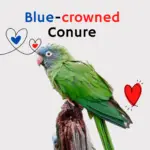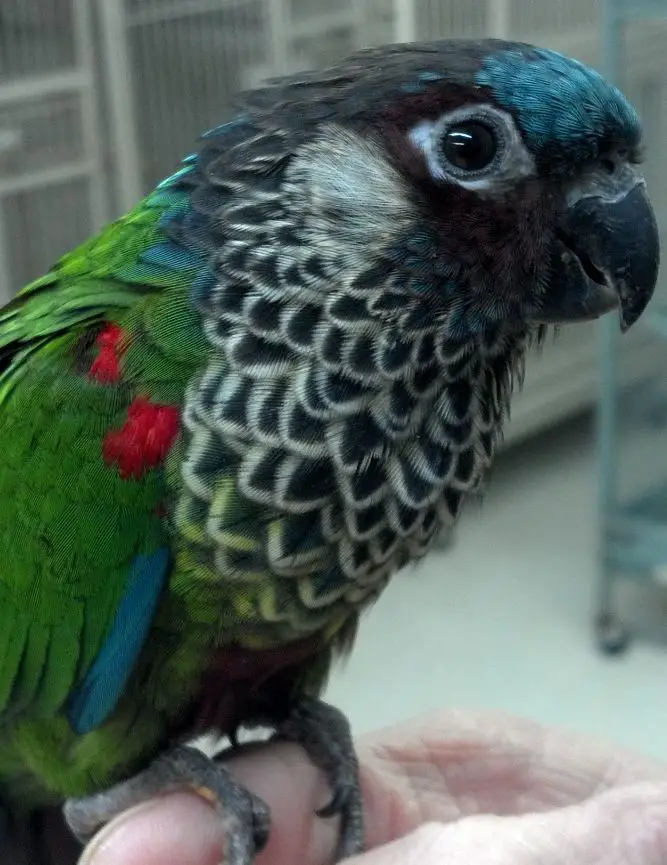
Conure Types: Under the term, Conure is grouped parrots and parakeets (family Psittacidae and subfamily Psittacinae) of small parrots to medium size belonging to several neotropical genera. The term conure derives from the genus Conurus which has fallen into disuse.
Description
Conures are rather slender parrots with pointed wings and long, pointed tails. The flapping of wings raised above the body is quite powerful. The distinction of species within certain genera (notably Aratinga and Pyrrhura) is sometimes delicate due to very strong similarities.
List of conure
- Aratinga
- Conuropsis (extinct genus)
- Cyanoliseus
- Enicognathus
- Eupsittula
- Guaruba
- Leptosittaca
- Myiopsitta
- Ognorhynchus
- Psittacara
- Pyrrhura
- Rhynchopsitta
- Thectocercus
List of conure species
- Black-cloaked conure – Pyrrhura rupicola
- White-collared conure – Pyrrhura albipectus
- Brown-fronted conure – Rhynchopsitta terrisi
- Red-fronted conure – Eupsittula canicularis, formerly Aratinga canicularis
- Red-throated conure – Psittacara rubritorquis, formerly Aratinga rubritorquis
- Big-billed conure – Rhynchopsitta pachyrhyncha
- Golden-cheeked conure – Ognorhynchus icterotis
- Long-billed conure – Enicognathus leptorhynchus
- Mumps conure – Pyrrhura hoematotis
- Golden brush conure – Leptosittaca branickii
- Brown-breasted conure – Pyrrhura calliptera
- Grey-breasted Conure – Pyrrhura griseipectus
- Blue-headed conure – Thectocercus acuticaudatus, formerly Aratinga acuticaudata
- Golden-headed conure – Aratinga auricapillus
- Red-headed conure – Psittacara erythrogenys, formerly Aratinga erythrogenys
- Red-bellied conure – Pyrrhura perlata
- Fire wing conure – Pyrrhura egregia
- Aztec conure – Eupsittula nana, formerly Aratinga nana
- Crowned conure – Eupsittula aurea, formerly Aratinga aurea
- Copper conure – Eupsittula pertinax, formerly Aratinga pertinax
- Orces conure – Pyrrhura orcesi
- Bonaparte’s conure – Pyrrhura lucianii
- Chapman’s conure – Aratinga alticola, currently considered a subspecies of the Mitrean Conure
- Cuban conure – Psittacara euops, formerly Aratinga euops
- Deville’s conure – Pyrrhura devillei
- Finsch’s conure – Psittacara finschi, formerly Aratinga finschi
- Hellmayr’s conure – Pyrrhura amazonum
- Hocking’s conure – Aratinga hockingi, currently considered a subspecies of the Mitred Conure
- Hoffmann’s conure – Pyrrhura hoffmanni
- Molina’s conure – Pyrrhura molinae
- Patagonian conure – Cyanoliseus patagonus
- Pfrimer’s conure – Pyrrhura pfrimeri
- Conure de Pinto – Aratinga maculata or Aratinga pintoi
- Ridgway’s conure – Psittacara strenuus, formerly Aratinga strenua
- Socorro’s conure – Psittacara brevipes, formerly Aratinga brevipes
- Souan conure – Pyrrhura melanura
- Vieillot’s conure – Pyrrhura frontalis
- Wagler’s conure – Psittacara wagleri, formerly Aratinga wagleri
- Weddell’s conure – Aratinga weddellii
- Cactus conure – Eupsittula cactorum, formerly Aratinga cactorum
- Santa Marta conure – Pyrrhura viridicata
- Golden conure – Guaruba guarouba
- Conure emma – Pyrrhura emma
- Conure jandaya – Aratinga jandaya
- Conure leucotique – Pyrrhura leucotis
- Conure magellanique – Enicognathus ferrugineus
- Master conure – Psittacara chloropterus, formerly Aratinga chloroptera
- Mitrated conure – Psittacara mitratus, formerly Aratinga mitrata
- Conure nanday – Aratinga nenday, formerly Nandayus nenday
- Pavuan conure – Psittacara leucophthalmus, formerly Aratinga leucophthalma
- Pearl conure – Pyrrhura lepida
- Reddening conure – Pyrrhura roseifrons
- Sun conure – Aratinga solstitialis
- Firehead conure – Pyrrhura rhodocephala
- Conure tiriba – Pyrrhura cruentata
- Versicolor conure – Pyrrhura picta
- Green conure – Psittacara holochlorus, formerly Aratinga holochlora
- Widowed conure – Myiopsitta monachus
Conure Mutations
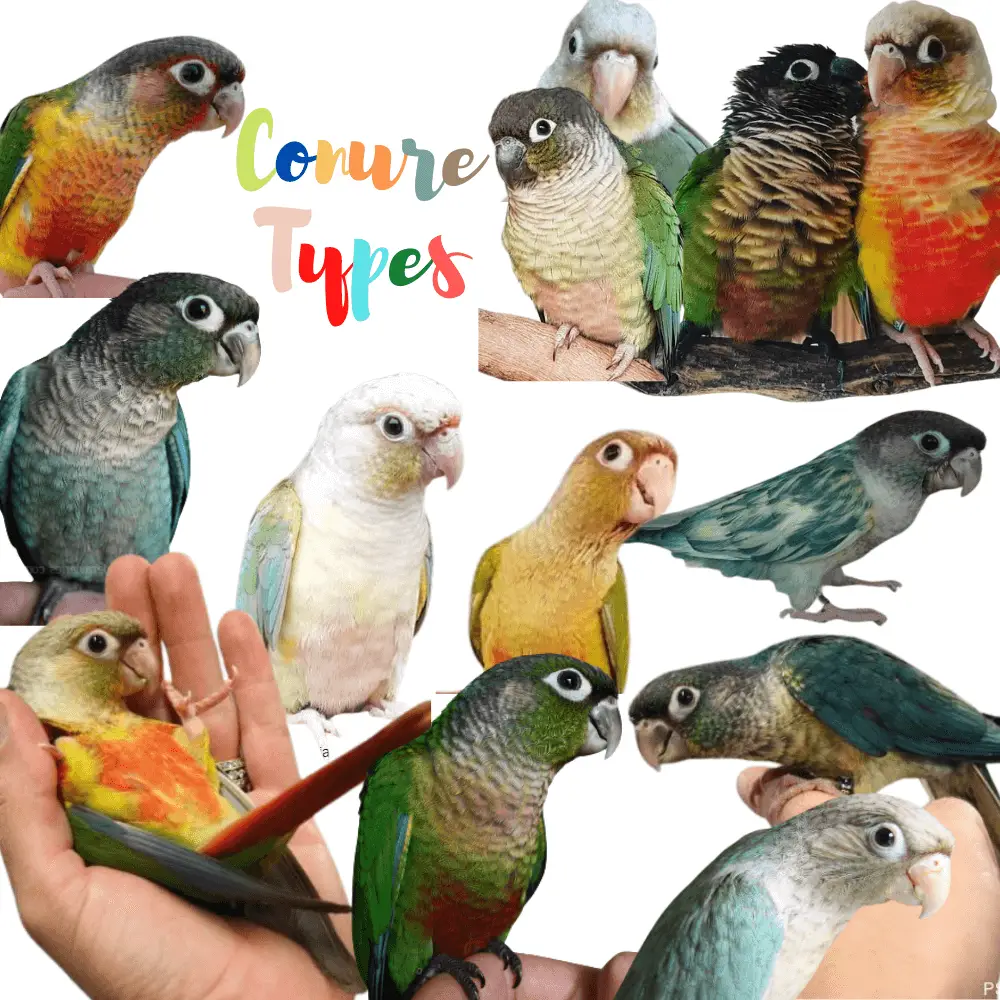
List of Conure Types mutations:
- Natural
- Cinnamon
- Pineapple
- Yellow-sided
- Turquoise
- Turquoise Cinnamon
- Turquoise Yellow-sided
- Turquoise Pineapple
- Jade (Misty)
- Pied
Natural Green cheeked Conure
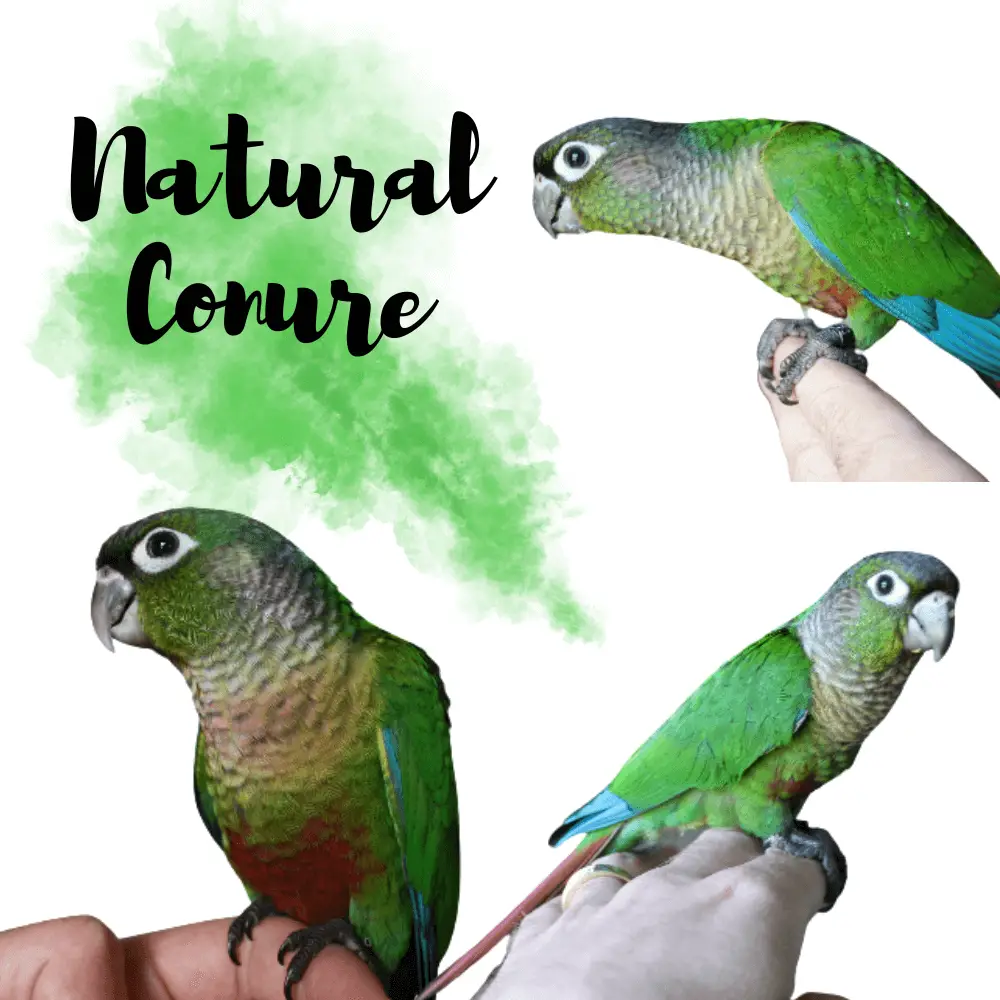
The natural Conure or The wild-type Green-Cheeked Conure is a richly colored green parrot, with a maroon tail, a dark green head, a dark beak sometimes dark and grey, and dark feet
Order: Psittaciformes
Family: Psittacidae
Genus: Pyrrhura
Size: About 26cm.
Longevity: 25 years.
Distribution: This bird is found confined to the highlands of eastern Bolivia.
Description: Its plumage is predominantly green, especially the cheeks, hence one of the names given to this species. Its chest has characteristic dark brown and light golden scales.Forehead, crown, nape, beak, and legs are black. The flight feathers are blue and the tail red. The eye-rings are white and the irises brown. Subspecies: Pyrrhura molinae molinae, Pyrrhura molinae phoenicura, Pyrrhura molinae restricta, Pyrrhura molinae australis, Pyrrhura molinae flavoptera.
Cinnamon Conure
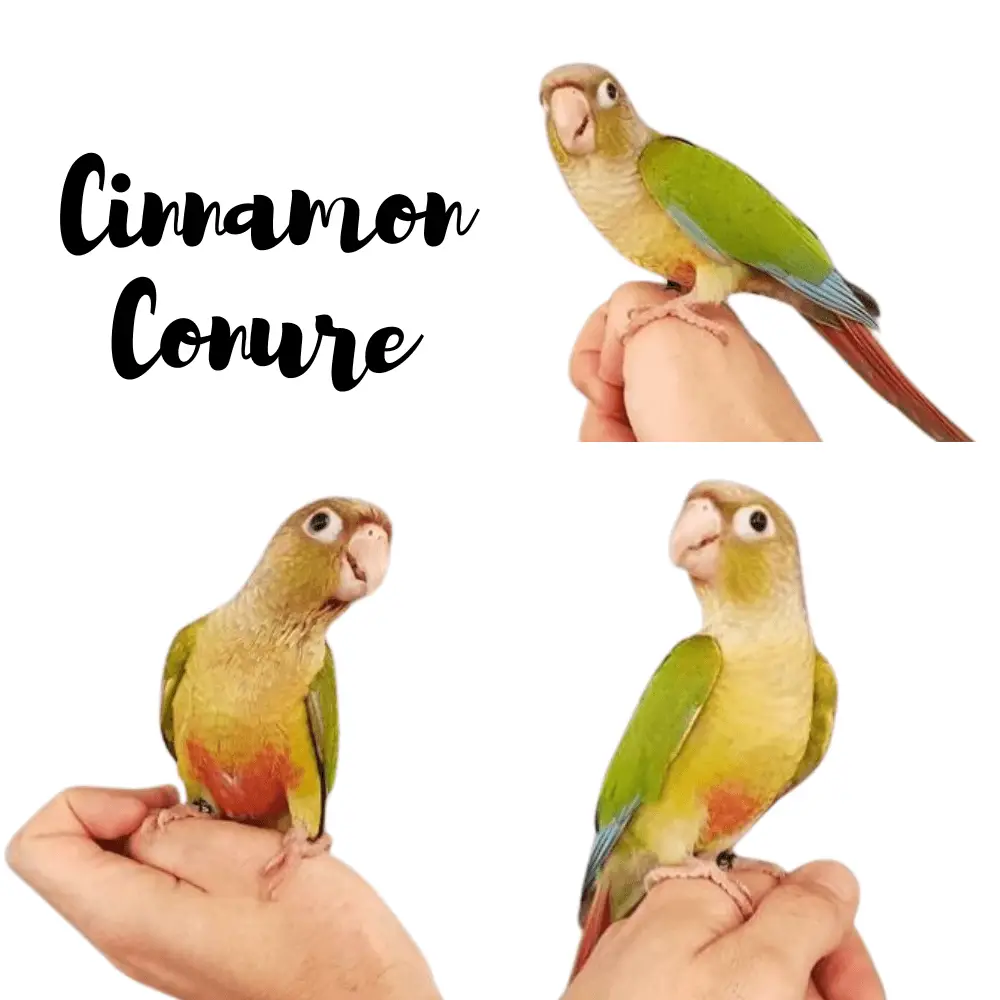
Cinnamon Conure This conure mutation is a light evenly washed color with a light-colored head and beak, also light-colored feet. It has ruby-red eyes and tends to fade with exposure to sunlight.
Pineapple Conure

Pineapple Conure This conure mutation is a visual mixture of a Yellow-Sided – Cinnamon. this conure mutation is coloration tends to fade with exposure to sunlight. It has ruby-red eyes. It has a light-colored head of Cinnamon and striking yellow sides of the Yellow-Sided.
Yellow-sided Conure
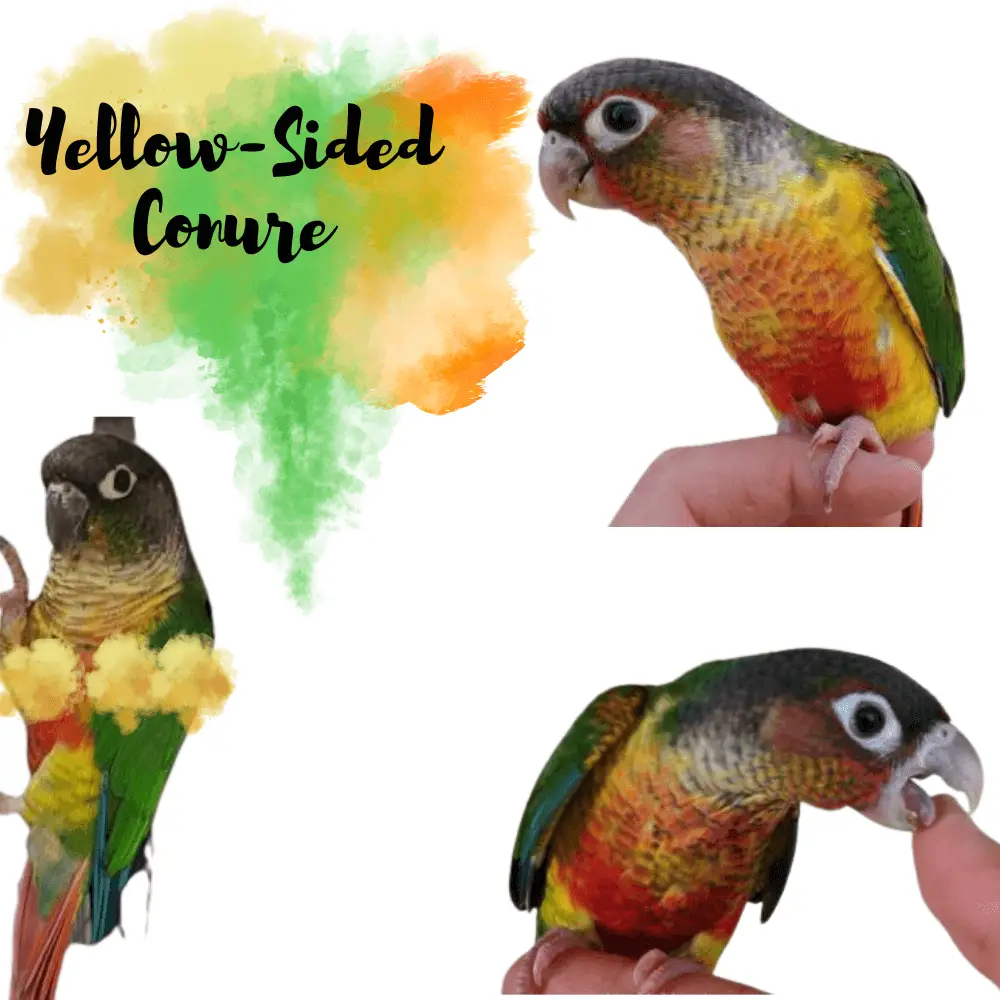
Yellow-sided Conure this conure mutation has a dark beak and feet with rich red and yellow colors from the Yellow-Sided this mutation looks very similar to a Jenday Conure and a light cream color from the American Dilute.
Turquoise Conure
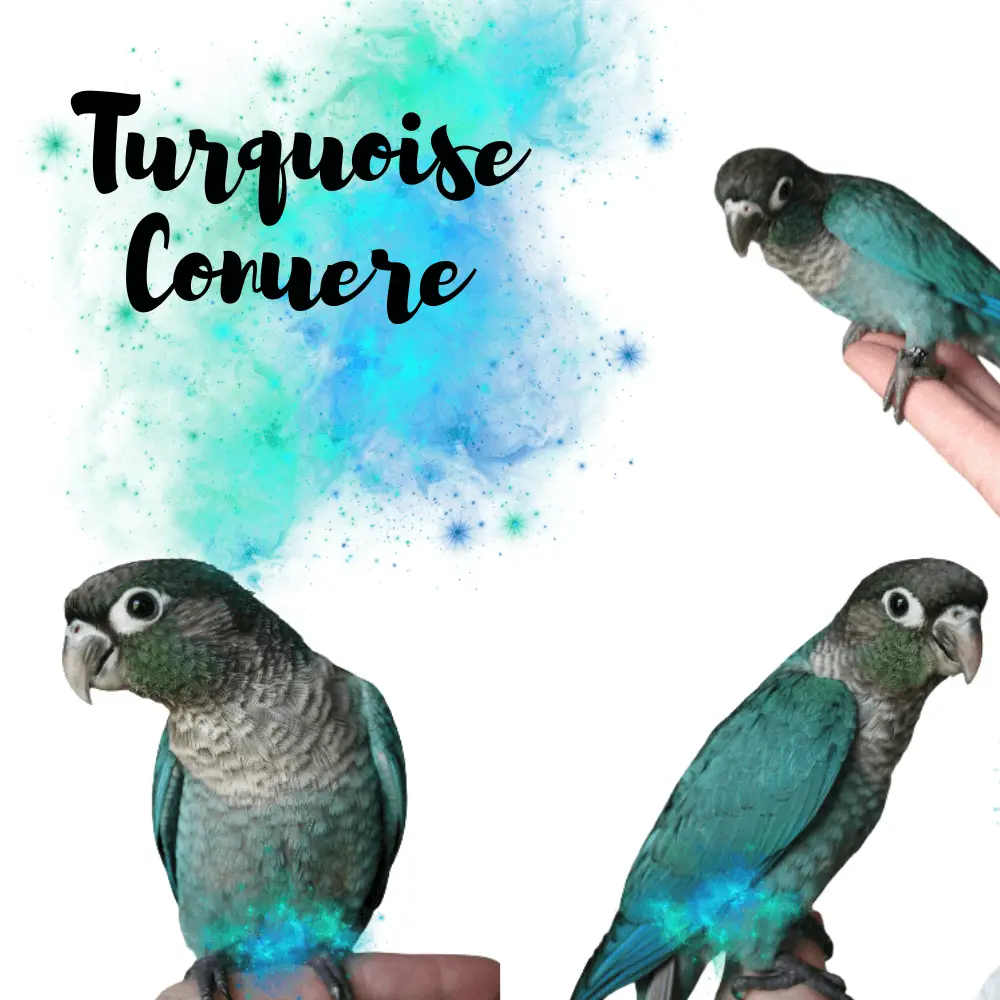
Turquoise conure is this conure mutation Named correctly, This parrot is a dark blue mixed with green and is the largest of the Green-Cheeked mutation colorations. Like the Pearly cockatiel, it seems to be larger than the other colors.
Turquoise Cinnamon Conure
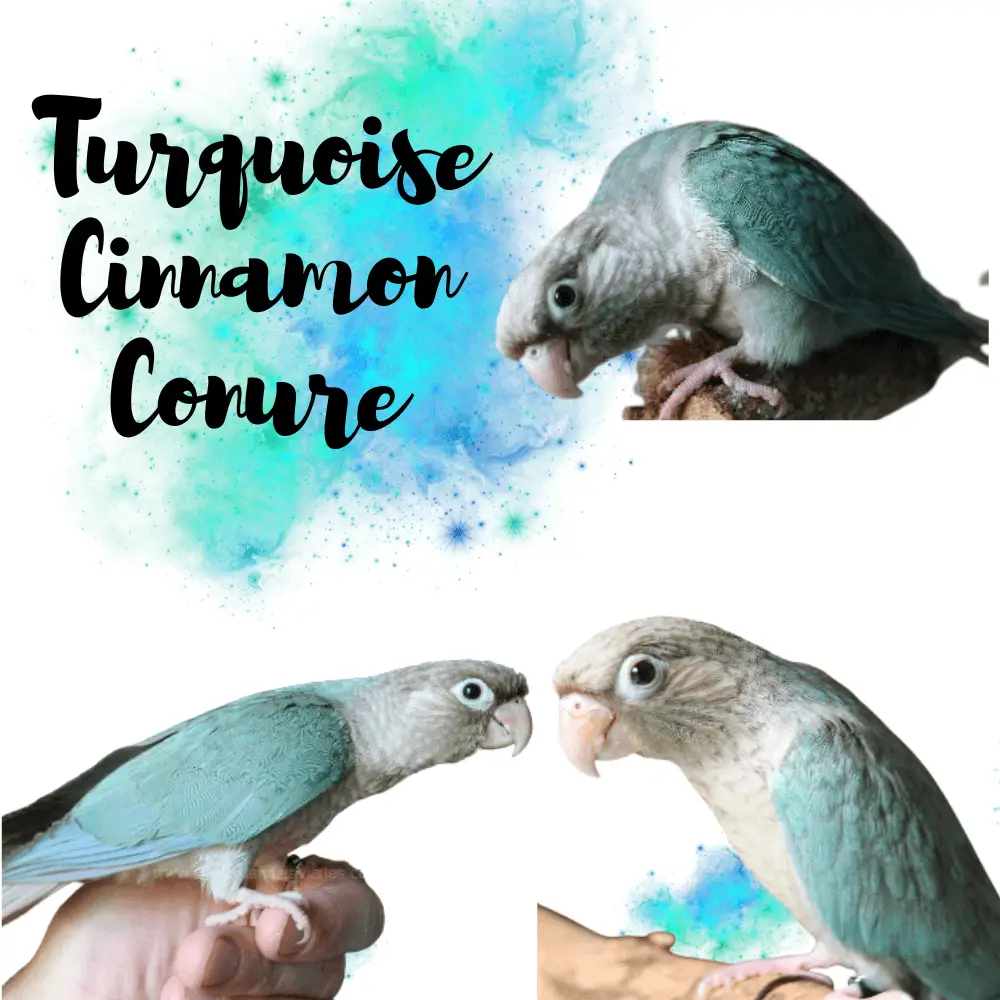
Turquoise cinnamon conure is this conure mutation it’s like turquoise conure, This parrot is light-colored blue mixed with grey and white and is the largest of the Green-Cheeked mutation colorations. Like turquoise conure.
Turquoise Yellow-sided Conure
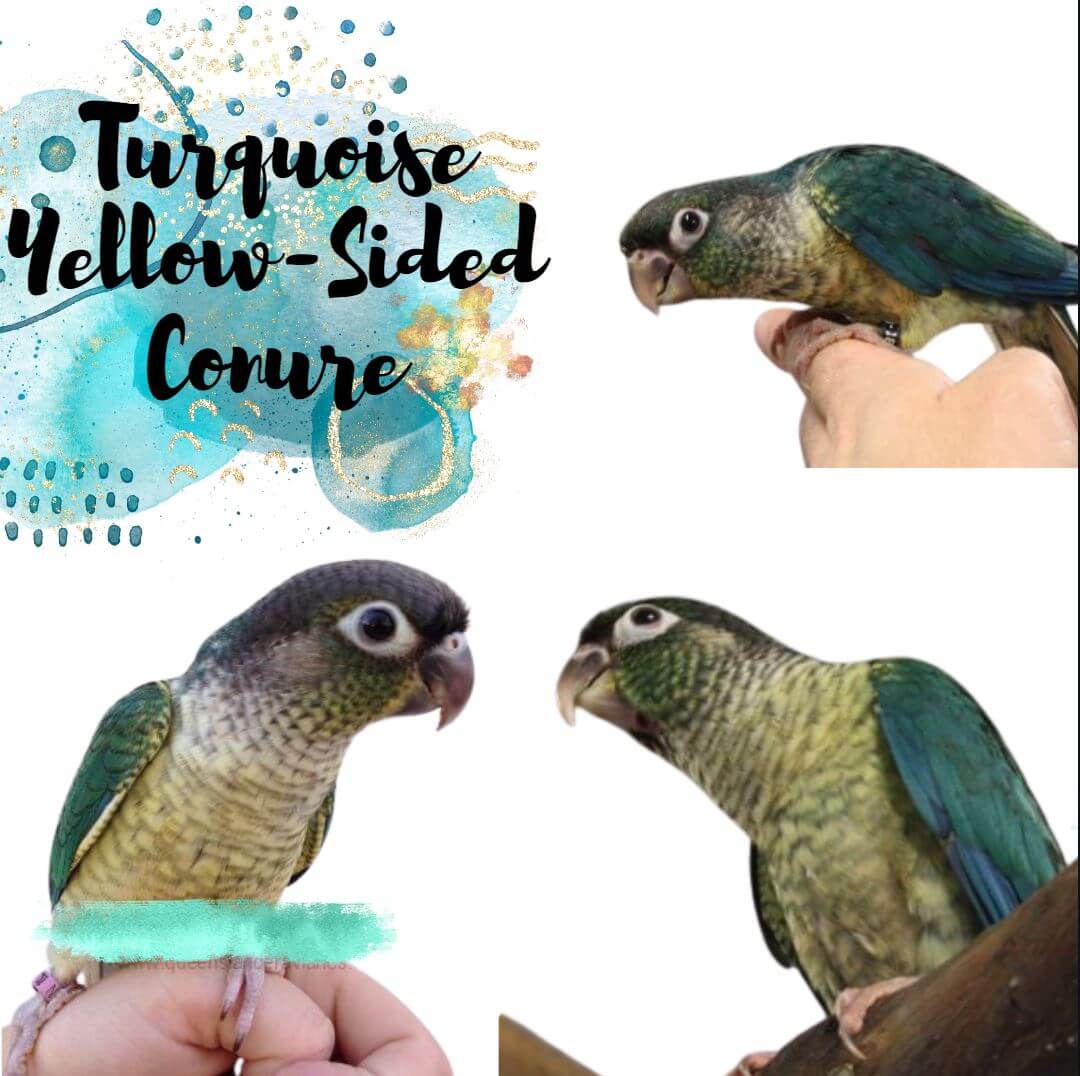
Turquoise Yellow-sided Conure is mixed between turquoise conure and yellow-sided conure, this conure mutation has a dark beak and white feet with grey-white and yellow colors from the Yellow-Sided this mutation looks very similar to a Jenday Conure but without the red color and a light cream color from the American Dilute and turquoise conure from the back.
Turquoise Pineapple Conure
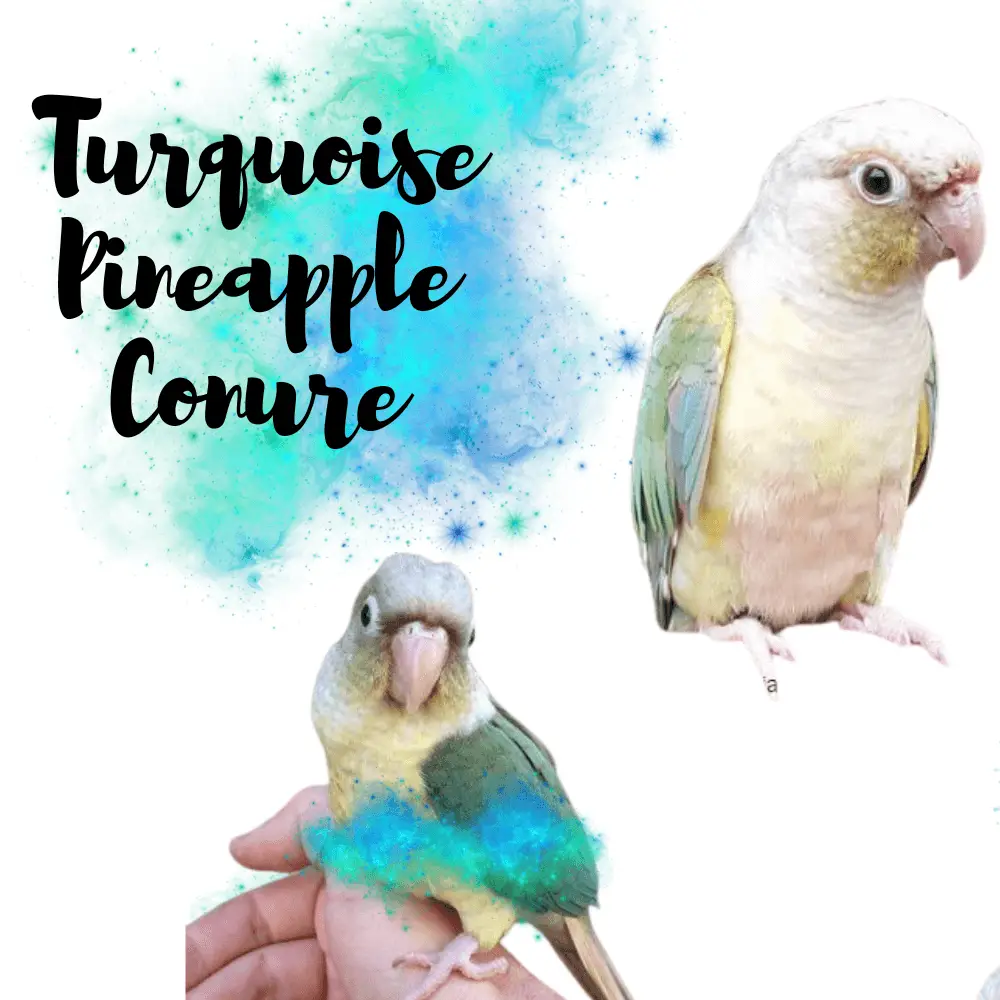
Turquoise Pineapple Conure This conure mutation is a visual mixture of a turquoise – Pineapple. this conure mutation is coloration tends to fade with exposure to sunlight. It has ruby-red eyes. It has a light-colored head of Cinnamon and blue and green and turquoise of the turquoise conure.
Jade Misty Conure

Jade Misty conure this conure mutation is similar to natural green cheek conure, is a richly colored green parrot, with a dark green head, a dark beak sometimes dark and grey, and dark feet but with a light-colored maroon tail
Pied Conure

The Pied conure is a rare mutation of conure color genetics, with mostly turquoise and blue-grey to light-yellow and white feathers and white cheek patches.
Pied conure has large, random blotches of color on their bodies, after the turquoise conure or yellow-sided conure or cinnamon of a conure plumage is primarily blue or yellow with prominent white flashes on the outer edges of each wing.
Different types of conures
All you need to know about different types of conures, There are two main types of Conures: Aratinga and Pyrrhura.
The are more than 40 different types of conure parrot species and they all have their own unique characteristics (color and size and lifespan, and behavior).
Sun Conure

Scientific name: Aratinga solstitialis
Order: Psittaciformes
Family: Psittacidae
Genus: Aratinga
Size: About 30 cm.
Longevity:
Distribution: The Sun Conure populates very open secondary forests, wooded savannahs, and palm groves. It is found in northern South America in Brazil, French Guiana, Guyana, Suriname, and Venezuela.
Description: The Sun Conure, as the name suggests, is a parrot with golden yellow plumage. Although its plumage is predominantly yellow,
the Sun Conure also sports other colors: orange shade on the face and belly, green primary and secondary covers, as well as the remiges at the blue ends.
The irises are brown, the eye circles, the beak, and the legs black. Juveniles have a greenish-yellow coloration with clear orange marks on the face and belly.
Subspecies: Aratinga maculata.
Jandaya Conure
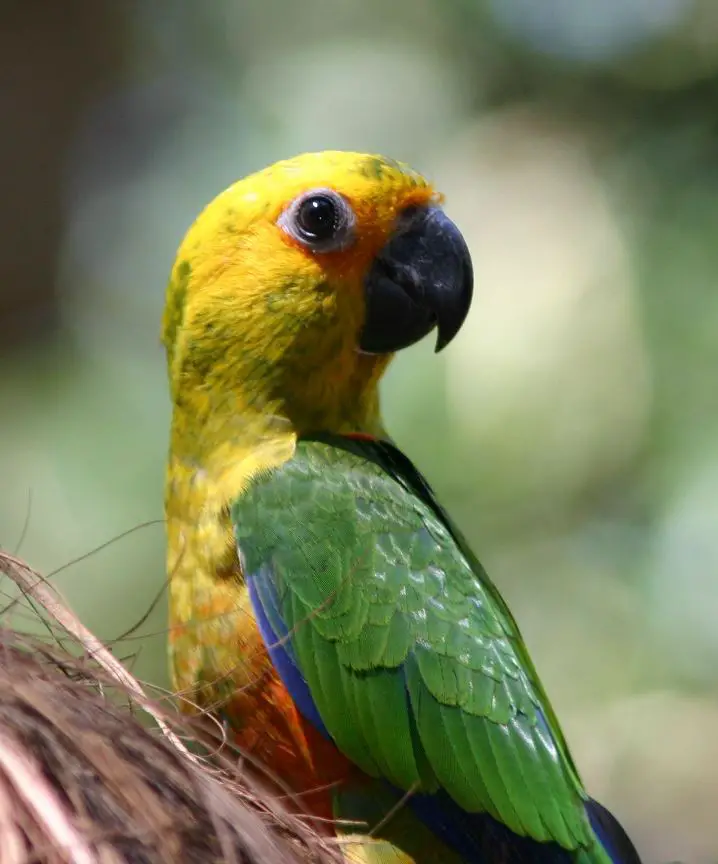
Family: Psittacidae
Genus: Aratinga
Size: Almost 30 cm.
Longevity:
Distribution: Northeast Brazil.
Description: The Conure jandaya is a very colorful conure. This species is of the genus Aratinga with the most multicolored plumage since its head and chest are yellow with a bright orange face mask, its wings, back, and tail are green, as are the remiges with blue and black tips.
The lower parts of the body have a mixture of yellow and light green. The eye circles are white, the irises brown, and the beak, and the legs black. Juveniles have a duller green coloration with orange-red breast and belly.
Aratinga Conure

Family: Psittacidae
Genus: Aratinga
Size: 25 to 30 cm,
Longevity: About 30 years.
Distribution: Northeastern Brazil
Description:
Subspecies: Aratinga Auricapillus Auricapillus, Aratinga Auricapillus Aurifrons
Distribution: This bird is found in Brazil, and Paraguay in southeastern Bolivia as well as northern and northeastern Argentina. It is a typical bird of the Pantanal and related humid regions.
Nanday Conure

Order: Psittaciformes
Family: Psittacidae
Genus: Aratinga
Size: About 28 cm for a mass of 96 to 129 g.
Longevity
Description: nanday conure is light green in color with a white spot on the chest and a black head. Its powerful beak allows it to dig deep cavities in some trees including the arancay palm. Like many other parakeets or parrots, this bird is noisy.
It is not uncommon for owners to reluctantly have to get rid of their companion following a complaint from their neighbors. The Nanday conure does not like to be alone.
Yet if we want to be able to interact with her, we must not put her in the presence of a congener, at the risk of seeing her disdain her breeder.
From then on, she will attach herself, sometimes exaggeratedly to her master: impossible not to open the cage to him when her master enters his home, as she shouts her joy to see him again.
She refuses to stay alone in a room and methodically follows her master everywhere in the house, including in the bathroom, during meals, she wants to be present and does not hesitate to peck on the plate of the one she considers her life companion.
At night, she likes to spend it in her companion’s room. The Nanday Parakeet is a wonderful pet for those who are willing to devote several hours in the day to her as she needs companionship.
Without it, it is cruel to imagine owning one, both for the animal and for the owner for whom the company of this bird can quickly turn into a nightmare if he does not take care of it properly.
Conures are very playful and curious birds. They are very active, so they will need several toys. They love to play and are a lot of fun to watch. Conures have a great need for attention and therefore need to be handled by their owner.
The Nanday, unlike many other parrots, gives its affection to the whole family and not just to one person. But since he is very intelligent, he develops over time a different treatment for each member of the family.
nanday conure makes very good companions. They are very intelligent and like to learn tricks. They are however quite noisy because their voice is powerful and they like to use it.
Weddell’s Conure
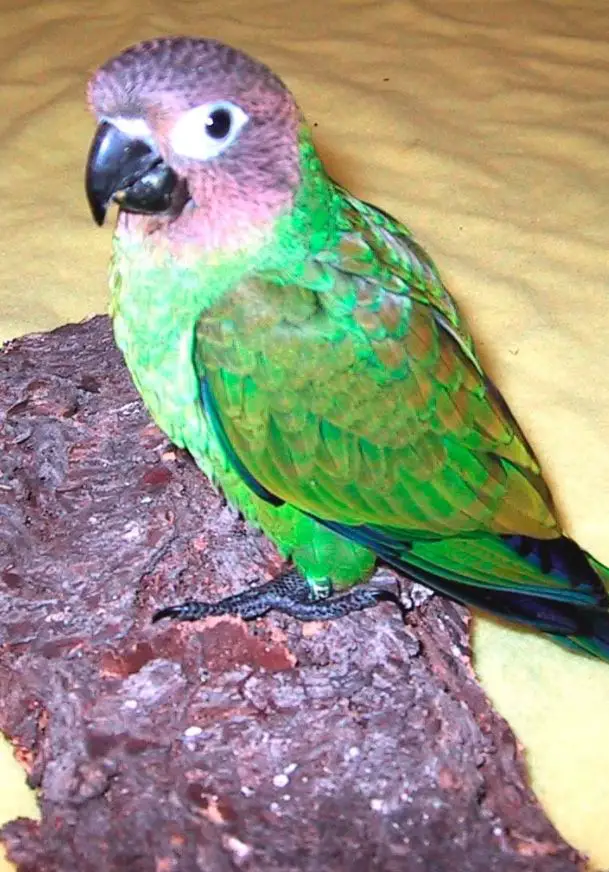
Distribution: Weddell’s Conure inhabits southeastern Colombia, eastern Ecuador, northern and eastern Peru, northeastern Bolivia, and northwestern Brazil (Mato Grosso).
This species lives in forests up to 750 m above sea level, in plains bordering humid forests along rivers, in marshes and valleys wooded with small shrubs, in coffee and sugar cane plantations.
Description: The Weddell’s Conure is a species close to the cactus conure. It has a predominantly dark green plumage (neck, coat, rump, a large part of the remiges, and the top of the rectrices).
The throat and upper chest are olive green. This color turns yellowish-green on the lower chest, belly, thighs, and area. The underside of the tail is dark gray.
The external primary remiges are black-bordered with blue, the others green with blue reflections. The head and chin are gray-brown with some feathers marked with an azure blue reflection giving a scaly appearance.
The lores and surroundings of the upper mandible have a pink reflection. The beak is black with a pink border at the base. The legs are dark gray with black gray fingers. The bare eye circles are whitish with pink reflections, black eyes, and yellow irises.
Behavior: The Weddell’s Conure lives in pairs or small groups but can cluster in flocks of a hundred individuals when food is plentiful. This species makes significant movements.
White-necked conure
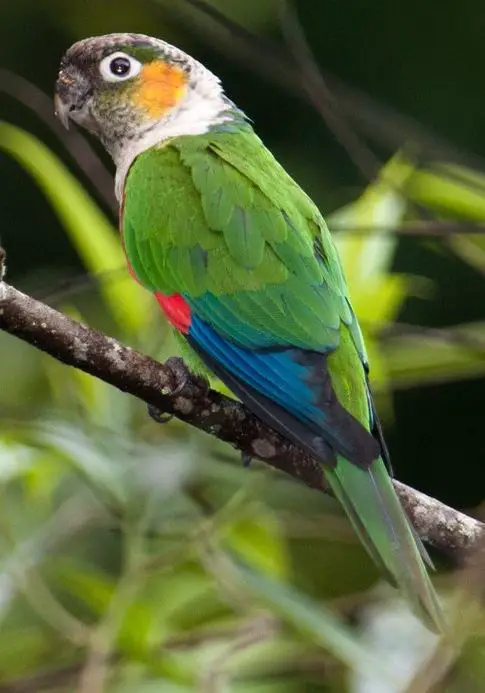
Scientific name: Pyrrhura albipectus
Order: Psittaciformes
Family: Psittacidae
Genus: Pyrrhura
Size: 24cm.
Distribution: This species inhabits primary forests between 1,400 and 1,800 m altitude. This bird lives in the southeast of Ecuador.
Description: It looks a lot like the Souancé’s Parakeet but can be distinguished by the white chest without scales and the orange periauricular areas.
Brown-breasted conure
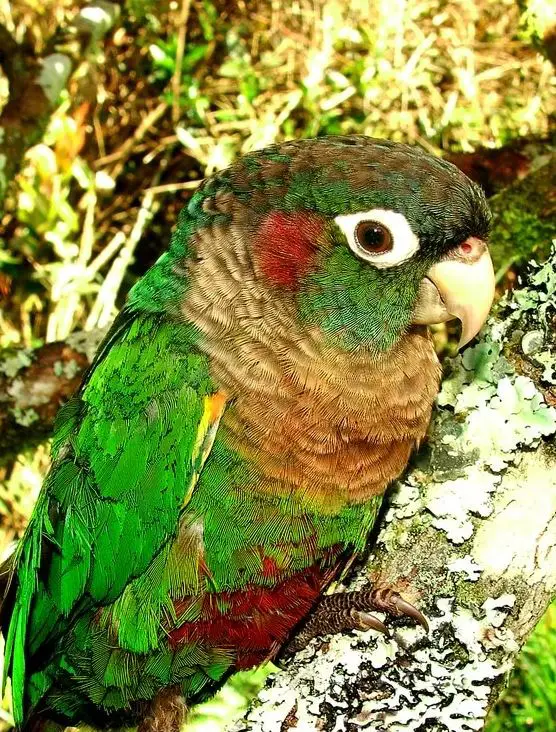
Scientific name: Pyrrhura calliptera
Order: Psittaciformes
Family: Psittacidae
Genus: Pyrrhura
Size: About 22cm.
Distribution: This species lives between 1,800 and 3,000 m altitude. This conure inhabits the Andes mountain range in Colombia.
Description: It is close to the Souancé Parakeet but is distinguished by the yellow wing borders and the red mark behind each ear
Tiriba conure

Scientific name: Pyrrhura cruentata
Order: Psittaciformes
Family: Psittacidae
Genus: Pyrrhura
Size: About 30 cm for a mass of 90 to 100 g. It is therefore the largest and heaviest species of the genus.
Distribution: This bird inhabits the humid Atlantic forests and their edges between 400 and 960 m of altitude. It still persists in some agricultural areas with trees. This species inhabits the coastal regions of eastern Brazil (states of Bahia, Minas Gerais, Espirito Santo, and Rio de Janeiro).
Description: Its plumage is predominantly green. Unlike other species of the genus Pyrrhura, its chest does not have scales.
Forehead, crown, and nape are blackish-brown with buff streaks. Lores and ear-coverts are orange-red. The lower cheeks are light green.
The throat and the top of the chest are nuanced with azure blue, the coloring being found in the form of a border at the level of the nape of the neck. The belly and rump are red, color is also found on the shoulders.
The primaries are blue. The tail is olive-green above and brownish-red below. The bill is blackish. The irises are orange-yellow to brown. Narrow bare eye-rings and legs are greyish.
Deville conure
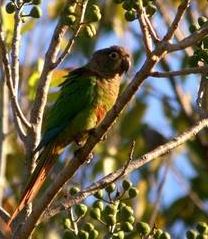
Scientific name: Pyrrhura devillei
Order: Psittaciformes
Family: Psittacidae
Genus: Pyrrhura
Size: About 24 to 26 cm with a mass of about 70 g.
Distribution: This species lives in a restricted area bounded by eastern Bolivia, northern Paraguay, and southwestern Brazil (Mato Grosso region).
Description: Close to the Parakeet of Old, it is distinguished by a less bright coloring. Its plumage is mostly brownish-green. Its head is brown with yellowish ear-coverts and green cheeks. The neck and plastron display the characteristic scales of the genus.
Fiery shouldered conure

Scientific name: Pyrrhura egregia
Order: Psittaciformes
Family: Psittacidae
Genus: Pyrrhura
Size: About 25 cm and weighs 75 grams.
Distribution: This bird inhabits mountain forests between 700 and 1800 m altitude. This bird lives in southeast Venezuela, west of Guyana, and northeast of Brazil.
Description: Its plumage is predominantly green with the characteristic scales of conures of the genus Pyrrhura. Its wings bear the same red and yellow markings as the Santa Marta Parakeet. This species is closely related to the Red-bellied Parakeet and Santa Marta Parakeet.
Subspecies: Pyrrhura egregia egregia, Pyrrhura egregia obscura (darker plumage).
Maroon bellied conure

Scientific name: Pyrrhura frontalis
Order: Psittaciformes
Family: Psittacidae
Genus: Pyrrhura
Size: About 26cm.
Longevity:
Distribution: It is native to South America in southeastern Brazil, southeastern Bahia east to Minas Gerais, and Espirito Santo to Rio de Janeiro and has been introduced to the United States and Canada.
Description: Its plumage is mostly green. The greenish-yellow chest and the red plastron are marked with the characteristic scales of the genus.
The rectrices are olive green with rufous-brown tips and underparts. The flight feathers are nuanced with azure blue. Orbital circles are white, irises and beak black, legs grey.
Subspecies: Pyrrhura frontalis, Pyrrhura frontalis Krieger, Pyrrhura frontalis chiripepe.
Blood eared conure
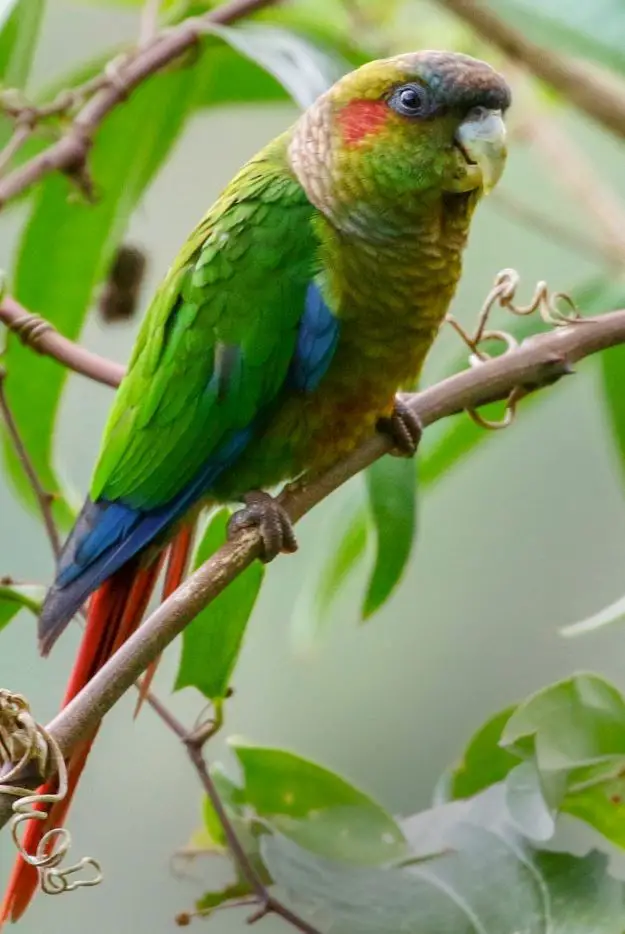
Scientific name: Pyrrhura hoematotis
Order: Psittaciformes
Family: Psittacidae
Genus: Pyrrhura
Size: About 25cm.
Longevity:
Distribution: This species lives between 1,000 and 2,000 m altitude. This bird is located in northern Venezuela.
Description: It looks a lot like the Souancé’s Parakeet but can be distinguished by the red periauricular zones, the less extensive scales, and the blue flight feathers.
Subspecies: Pyrrhura hoematotis hoematotis, Pyrrhura hoematotis immarginata.
Hoffmann’s conure
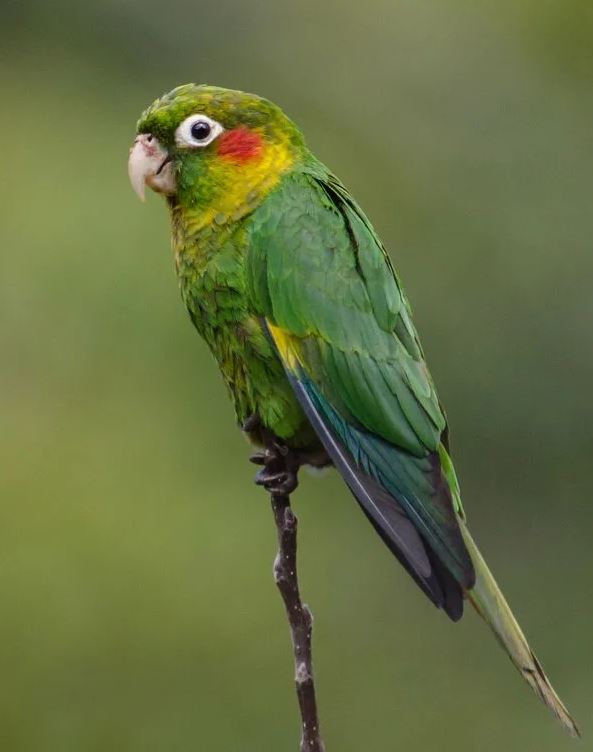
Scientific name: Pyrrhura hoffmanni
Order: Psittaciformes
Family: Psittacidae
Genus: Pyrrhura
Size: About 24cm.
Longevity:
Distribution: Hoffmann’s conure is a species of conure, parakeet endemic to southern Costa Rica and western Panama.
It inhabits humid forests, mountain wastelands, between 700 and 3000 meters of altitude in southern Central America, Costa Rica, and western Panama.
Description: The scientific name and the French standardized name pay homage to the German naturalist Karl Hoffmann. This species is close to the Souancé Parakeet.
It is distinguished by the yellow and green scales covering the head, the neck, the chest, and part of the belly allied to the absence of a breastplate on the bottom of the chest and the belly. She has a red mark behind each ear. The flight feathers are bluish.
Subspecies: Pyrrhura hoffmanni hoffmanni, Pyrrhura hoffmanni gaudens.
Pearly conure
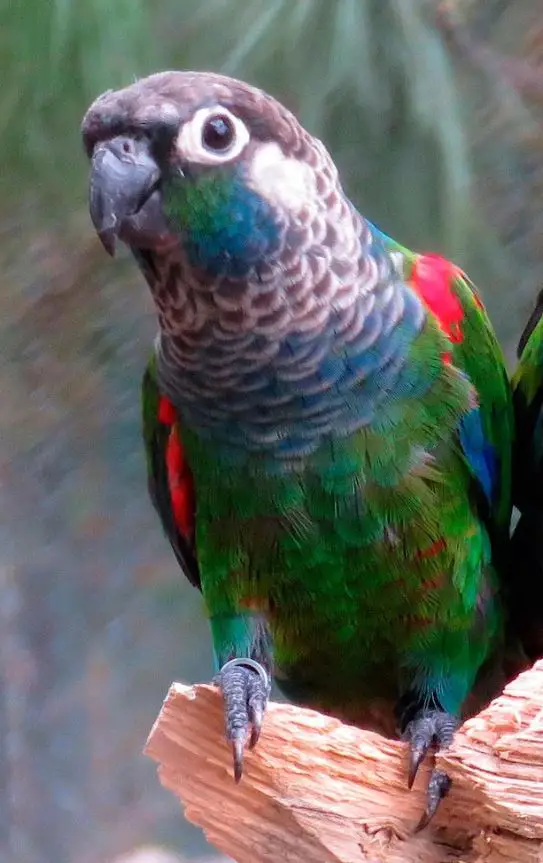
Scientific name: Pyrrhura lepida
Order: Psittaciformes
Family: Psittacidae
Genus: Pyrrhura
Cast: Brazil
Subspecies: Pyrrhura lepida lepida, Pyrrhura lepida anerythra, Pyrrhura lepida coerulescens, Pyrrhura lepida ssp. Nov.
Maroon faced conure

Scientific name: Pyrrhura leucotis
Order: Psittaciformes
Family: Psittacidae
Genus: Pyrrhura
Size: About 22cm.
Longevity:
Distribution: Its range is particularly fragmented, one population in northern Venezuela, another in the Brazilian state of Ceára,
yet another in the Brazilian state of Goiás, and a fourth in the region of Sao Paulo, and finally the larger population that occupies an area that extends from the coast of the state of Bahia to Mato Grosso.
Description: Close to the Gray Parakeet, it is distinguished by the white periauricular areas (instead of silvery white) and the greater extension of the azure coloration on the forehead, also found on the scaly pattern.
Subspecies: Leucotis (with brown and blue head), Griseipectus (with grayish head and grayish chest), Pfrimeri (with sky blue head and pale throat),
Emma (with sky blue head as well but overall darker coloring), Auricularis (with sky blue forehead, throat with the same color and white scales and breast with greenish-brown scales).
Maroon tailed conure
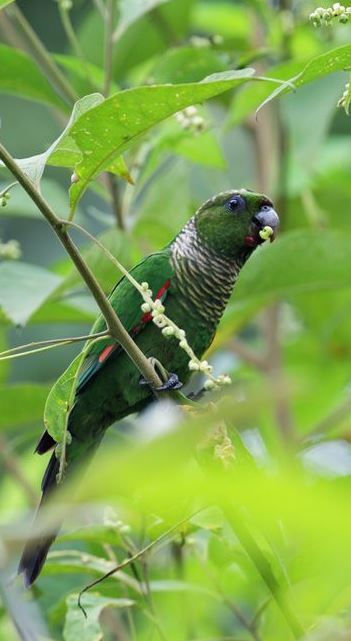
Scientific name: Pyrrhura melanura
Order: Psittaciformes
Family: Psittacidae
Genus: Pyrrhura
Size: About 24cm.
Longevity:
Distribution: Confined to northeast Peru, Brazil in the northwest section of the Amazonas state, from the upper Orinoco River east to the Rio Negro. This area extends from the extreme east and south of Colombia to Venezuela in the provinces of Amazonas and Bolivar.
Description: It has green plumage with black and white scales on the throat, neck, and upper breast. The edge of the wings is red with more or less marked yellow scales. The rectrices and the ventral plastron are brick red. The eye rings are white and the irises brown. Beak and legs are grey.
This bird resembles other species of conures that have often been considered mere subspecies: Black-capped Parakeet, White-collared Parakeet, Eared Parakeet, Hoffmann’s Parakeet, Brown-breasted Parakeet, Berlepsch’s Parakeet, Parakeet forehead.
Subspecies: Pyrrhura melanura melanura, Pyrrhura melanura souancei (characterized by a rather large patch on each shoulder and the absence of yellow), Pyrrhura berlepschi (showing paler and more extensive scales on the breast as well as red wingbars devoid of yellow), Pyrrhura melanura pacifica, Pyrrhura melanura chapmani, Pyrrhura orcesi.
EL oro conure

Scientific name: Pyrrhura orcesi
Order: Psittaciformes
Family: Psittacidae
Genus: Pyrrhura
Size: About 22cm.
Longevity:
Distribution: This species is endemic to the province of El Oro in Ecuador where its population is extremely small (20 to 60 individuals).
Description: Its plumage has a green cast. The forehead is reddish. The eyes with greyish irises are circled in white. The wing-coverts are bright red and the flight feathers blue.
The chest has very slight chipping. The beak is a horn and the legs are grey. The female has green lores. The young have dark brown irises.
Crimson bellied conure
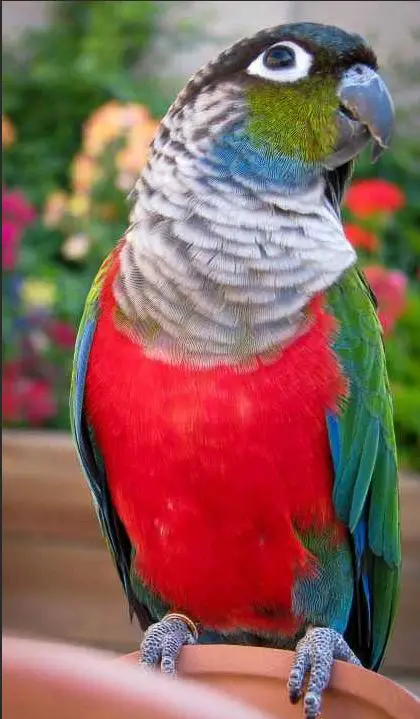
Scientific name: Pyrrhura perlata
Order: Psittaciformes
Family: Psittacidae
Genus: Pyrrhura
Size: About 24cm.
Longevity:
Distribution: This bird originally lives in very dense, often humid primary forests. However, it has adapted to certain deforested environments.
This bird lives in a restricted area of northern Brazil between the Amazon River north of Mato Grosso to the Rio Madeira and Tapajos rivers.
Description: Like other conures of the genus Pyrrhura, the adult has a characteristic scaly pattern. On a brown background, it consists of red scales.
The set covers a large part of the head, back, and chest. The feathers of the cheeks and the throat show sky blue reflections. The breeches are azure gray and the flight feathers blue.
The white eye-rings are very conspicuous. The irises are brown. The beak is black with a well-developed cere. The legs are grey-pink (black in the juvenile). The juvenile has predominantly green plumage with a brown head with azure reflections.
The characteristic scaly patterns of the genus mark the throat and neck and extend to the ears. The very large, bright red breastplate covers the chest and belly.
The shoulders are marked with red, coloration found under the wings. The flight feathers are blue with black tips. The tail has a wine color.
Painted conure
Scientific name: Pyrrhura picta
Order: Psittaciformes
Family: Psittacidae
Genus: Pyrrhura
Size: About 22cm.
Longevity:
Distribution: Southern Venezuela, northeastern Brazil, and eastern Guyana.
Description: It has mostly warm green plumage, darker coloring on the upper parts. The forehead is azure blue, a nuance found on the brick-red cheeks.
The periauricular areas are silvery white. The characteristic scaly pattern of the genus Pyrrhura is very marked on the neck and chest due to the contrast between black and yellow.
The reddish ventral plastron is well defined as well as the markings, also reddish on the rump and the tail.
Subspecies: Pyrrhura picta picta, Pyrrhura amazon (Hellmayr’s parakeet), Pyrrhura caeruleiceps (Todd’s parakeet), Pyrrhura picta eisenmanni (Eisenmann’s parakeet), Pyrrhura Luciani (Bonaparte’s parakeet), Pyrrhura peruviana (Peruvian parakeet), Pyrrhura rose front (blushing conure), Pyrrhura snethlageae (Snethlage conure).
Rose crowned conure
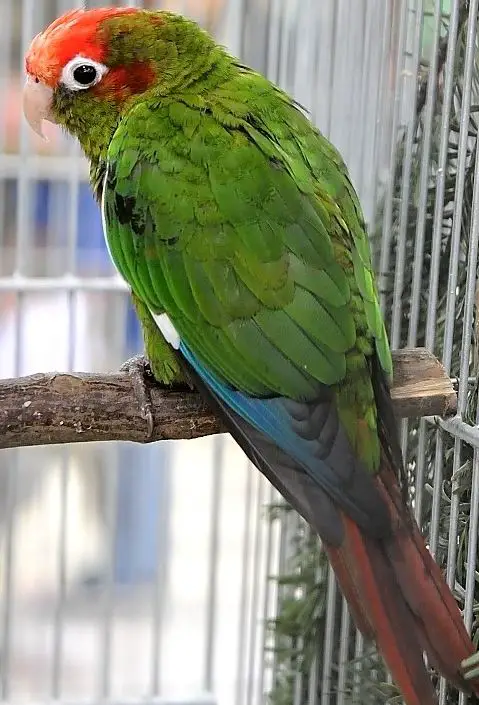
Scientific name: Pyrrhura rhodocephala
Order: Psittaciformes
Family: Psittacidae
Genus: Pyrrhura
Size: About 24cm.
Longevity:
Distribution: This species lives between 1,500 and 2,000 m altitude. This conure inhabits northwestern Venezuela.
Black-capped conure
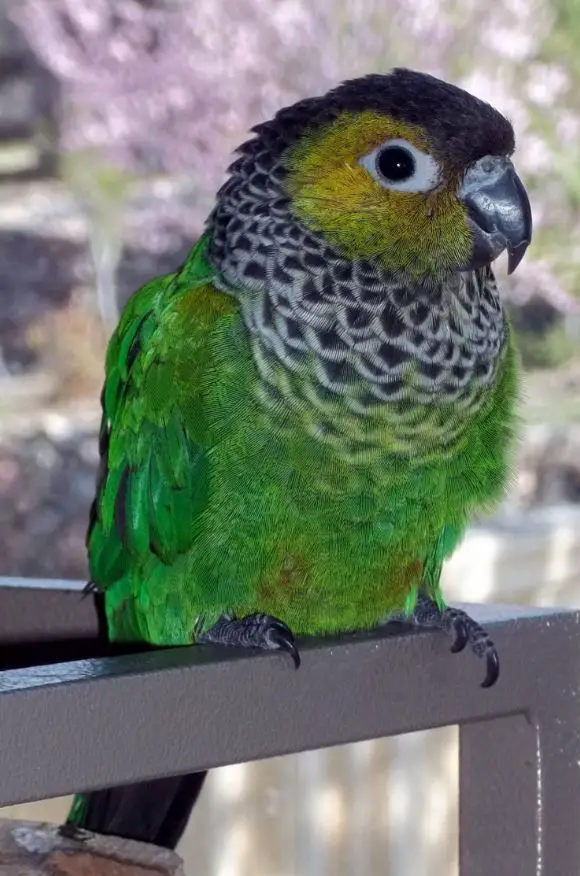
Scientific name: Pyrrhura rupicola
Order: Psittaciformes
Family: Psittacidae
Genus: Pyrrhura
Size: About 25cm.
Longevity:
Distribution: This bird inhabits the Amazon basin.
Description: This bird is closely related to the Souancé’s Parakeet.
Subspecies: Pyrrhura rupicola rupicola, Pyrrhura rupicola sandiae.
Santa Marta conure

Scientific Name: Pyrrhura viridicata
Order: Psittaciformes
Family: Psittacidae
Genus: Pyrrhura
Size: About 25cm.
Longevity:
Distribution: This bird inhabits primary forests between 1,800 and 2,800 m altitude. This species was widespread in a very restricted area in the Sierra Nevada de Santa Marta in Colombia.
Description: It is close to the Red-bellied Parakeet but has mostly green plumage with a red breast band and a smaller ventral plastron.
She has red undertones on the shoulders, on the underside of the tail, under the wings (where they are mixed with yellow), and on the periauricular areas.
Marijuana and cocaine crops, then herbicides used to destroy drug crops have reduced the habitat of this species by 85%, bringing it to the brink of extinction. Only 200 individuals remain in the wild.
Brown-throated conure
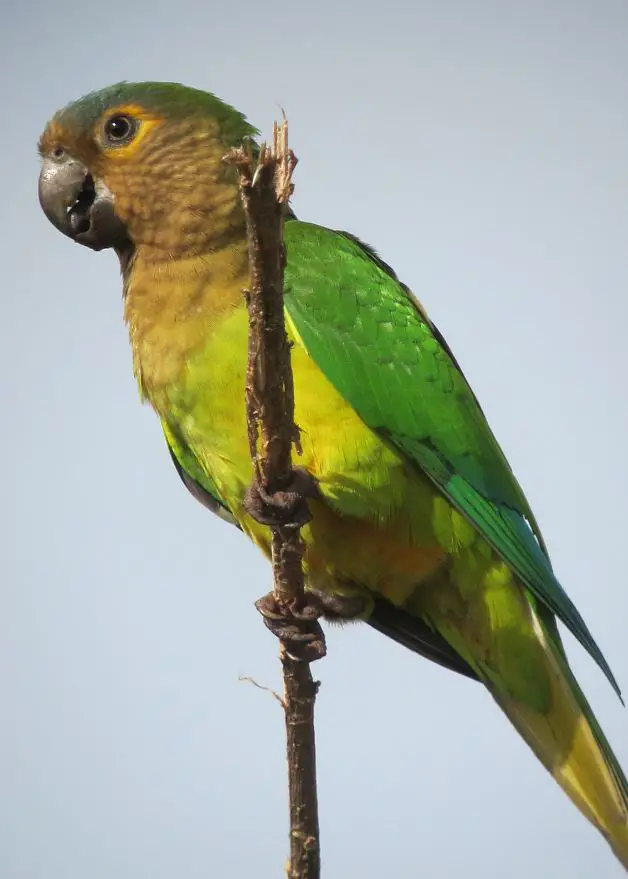
Scientific name: Eupsittula pertinax
Order: Psittaciformes
Family: Psittacidae
Genus: Eupsittula
Size: About 25cm.
Longevity:
Distribution: Curacao and Saint Thomas.
Description: The Copper Parakeet’s head and chest are heavily tinged with orange-yellow. The rest of the body has a green cast.
Subspecies: Eupsittula pertinax pertinax, Eupsittula pertinax surinama, Eupsittula pertinax aeruginosa, Eupsittula pertinax griseipecta, Eupsittula pertinax lehmanni, Eupsittula pertinax arubensis, Eupsittula pertinax xanthogenia, Eupsittula pertinax tortugensis, Eupsittula pertinax margaritensis, Eupsittula pertinax venezuelae, Eupsittula pertinax venezuelae, Eupsittula pertinax venezuelae, Eupsittula pertinax venezuelae , Eupsittula pertinax paraensis, Eupsittula pertinax ocularis.
Olive throated conure

Scientific name: Eupsittula nana
Order: Psittaciformes
Family: Psittacidae
Genus: Eupsittula
Size: 26cm.
Longevity:
Cast: Jamaica
Subspecies: Eupsittula astec astec, Eupsittula astec million, Eupsittula astec vicinalis
The subspecies, Eupsittula astec astec
Mitred conure
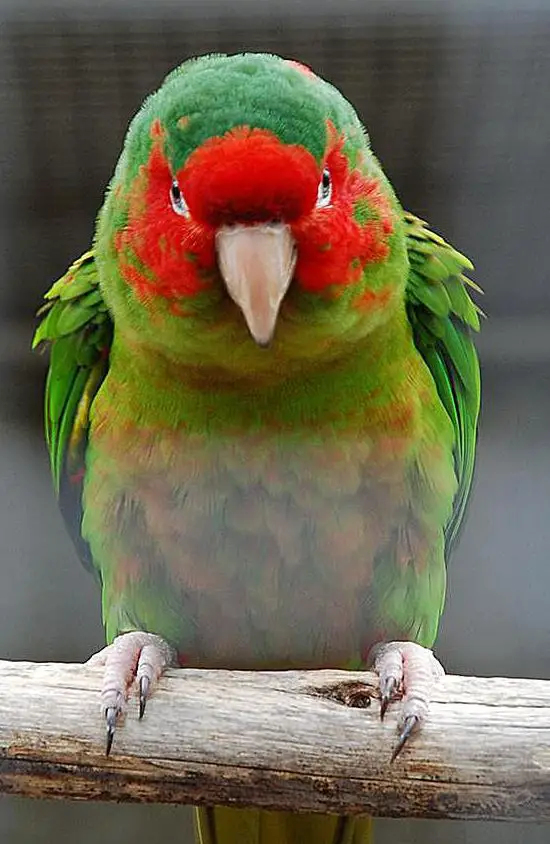
Scientific name: Psittacara mitratus
Order: Psittaciformes
Family: Psittacidae
Genre: Psittacara
Size: 38cm.
Longevity:
Distribution: Peru, Bolivia and Argentina.
Description: This species belongs to the group of red-fronted green conures along with Finsch’s Parakeet, Red-headed Parakeet, and Wagler’s Parakeet. Its green body is dotted with red feathers. He also has red on his forehead, cheeks, and lores.
Subspecies: Chlorogenys, Tucuman, Hocking, Alticola.
White-eyed conure
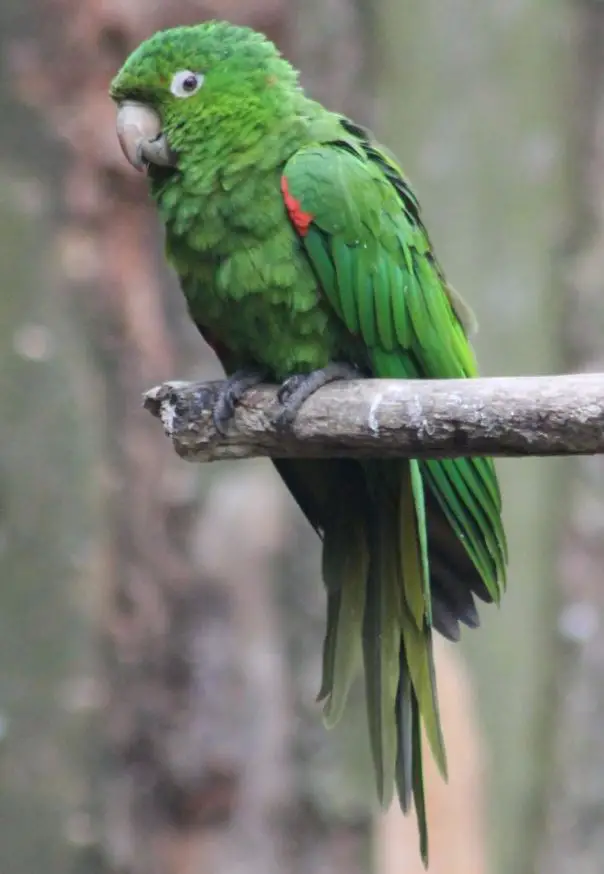
Scientific name: Psittacara leucophthalmus
Order: Psittaciformes
Family: Psittacidae
Genre: Psittacara
Size: 32cm.
Longevity:
Distribution: Colombia, Venezuela, Brazil, Bolivia, Argentina, Paraguay, and Uruguay
Subspecies: Leucophthalma, Nicefori, Callogenys.
Pacific conure
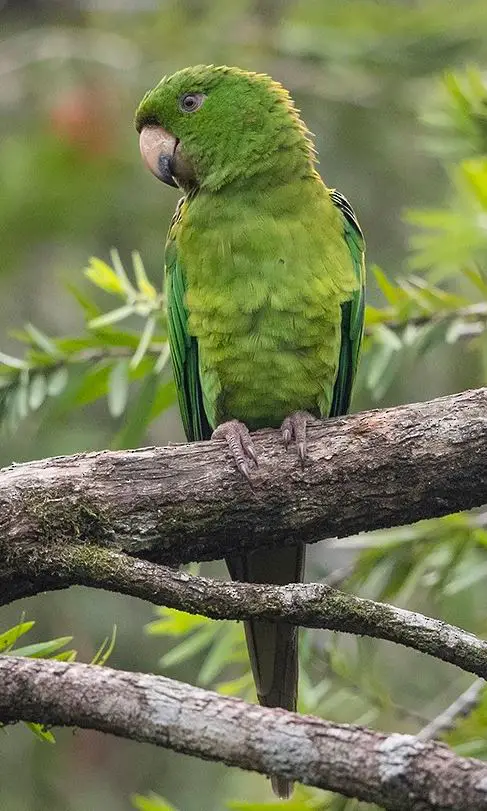
Scientific name: Psittacara strenuous
Order: Psittaciformes
Family: Psittacidae
Genre: Psittacara
Longevity:
Distribution: Found in open woods, pine forests, arid scrub, and cultivated areas on the Pacific coast of central Central America from Oaxaca and Chiapas, Mexico, south western Nicaragua.
Description: With its green plumage, this bird looks a lot like the green conure. The outline of his eye is gray and his eye is orange.
Socorro conure

scientific name: Psittacara brevipes
Order: Psittaciformes
Family: Psittacidae
Genre: Psittacara
Size: 34cm
Longevity: 22 years
Distribution: Socorro Island.
Description: With its green plumage, this bird closely resembles the Green Parakeet, of which it was long considered a mere subspecies.
However, it has a more modest size, shorter tarsi, and darker plumage. The Psittacara recipe is a rare bird.
Red-throated conure

Scientific name: Psittacara rubritorquis
Order: Psittaciformes
Family: Psittacidae
Genre: Psittacara
Longevity: 23 years
Distribution: Range spans Guatemala, El Salvador, Honduras, and Nicaragua.
Description: This bird has green plumage with a red mark, streaked with yellow, on the throat and chest.
Green conure
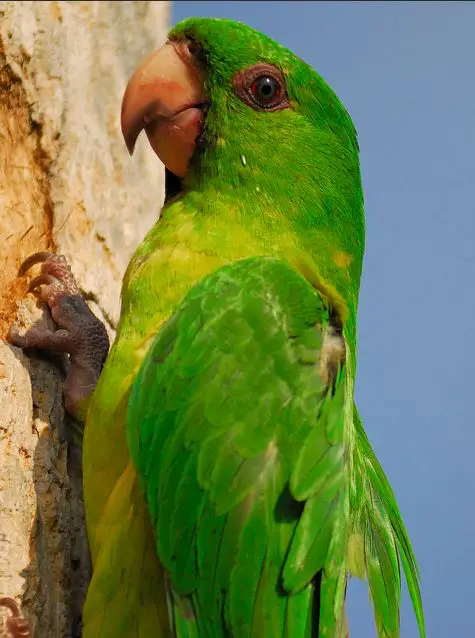
Scientific name: Psittacara holochlorus
Order: Psittaciformes
Family: Psittacidae
Genre: Psittacara
Size: About 32cm.
Longevity: 20 to 30 years
Distribution: The range extends into Mexico, Guatemala, Honduras, El Salvador, and Nicaragua.
Description: As its scientific name suggests, this species is entirely green. Its beak is gray. The orbital circles are white and the irises orange. The legs are grey.
Subspecies: Brewsteri, Rubritorquis, Brevipes, Strenua
Finsch’s conure

Scientific name: Psittacara finschi
Order: Psittaciformes
Family: Psittacidae
Genre: Psittacara
Size: About 28cm.
Longevity: 15 – 20 years
Distribution: Finsch’s Parakeet is a bird found in Central America from Costa Rica, Nicaragua, and Panama.
Description: It has predominantly green plumage with a red forehead, shoulders, and underwings. The eye-rings are white and the irises orange. The beak is pinkish gray and the legs are grey.
In juveniles, the red of the forehead is less extensive or completely absent. The coloring of the underside of the wings is duller. This species belongs to the group of red-fronted green conures along with the Red-headed Parakeet, Mitred Parakeet, and Wagler’s Parakeet.
Finsch’s conure
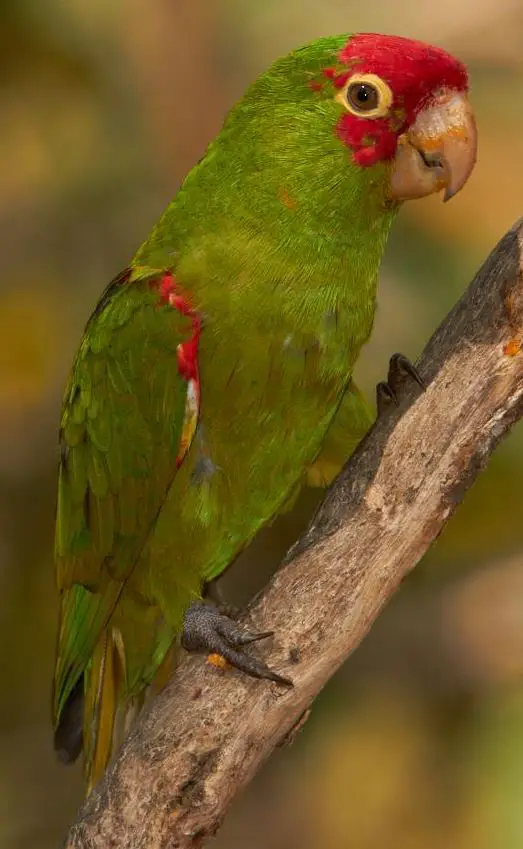
Scientific name: Psittacara erythrogenys
Order: Psittaciformes
Family: Psittacidae
Genre: Psittacara
Size: About 33cm.
Longevity: 40 years
Distribution: This bird lives in wooded savannah most often up to 1000 m altitude and very rarely up to 2500 m. This species inhabits a restricted area between southeastern Ecuador and northern Peru.
Description: The plumage is mostly more or less dark green and more or less yellow. The face to the back of the eyes, shoulders, and breeches are red.
The beak is horn gray and the legs are gray or black. The irises are yellow and the bare eye-rings white. Juveniles have completely green heads.
This species belongs to the group of red-fronted green conures with Finsch’s Parakeet, Mitred Parakeet and Wagler’s Parakeet.
The Red-headed Parakeet is extremely rare in captivity where it is present only in a few breedings where however it reproduces very well.
Cuban conure
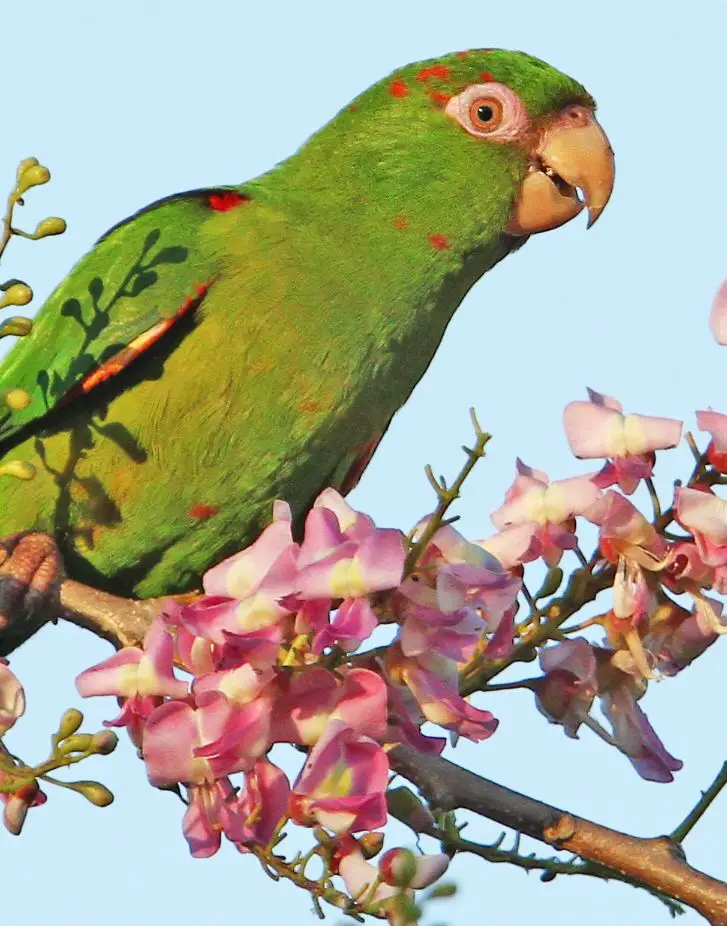
Scientific name: Psittacara euops
Order: Psittaciformes
Family: Psittacidae
Genre: Psittacara
Size: The male measures 28.5 centimeters and the female 27.5 centimeters.
Longevity: 50 – 60 years
Distribution: This species is endemic to Cuba.
Hispaniolan conure

Scientific name: Psittacara chloropterus
Order: Psittaciformes
Family: Psittacidae
Genre: Psittacara
Size: 30cm
Distribution: This bird lives mainly on the island of Haiti and the Dominican Republic.
Description: Mostly green, red wing curvature. Naked eye ring and buff color. Yellow eye.
Subspecies: Psittacara maugei
Hispaniolan conure
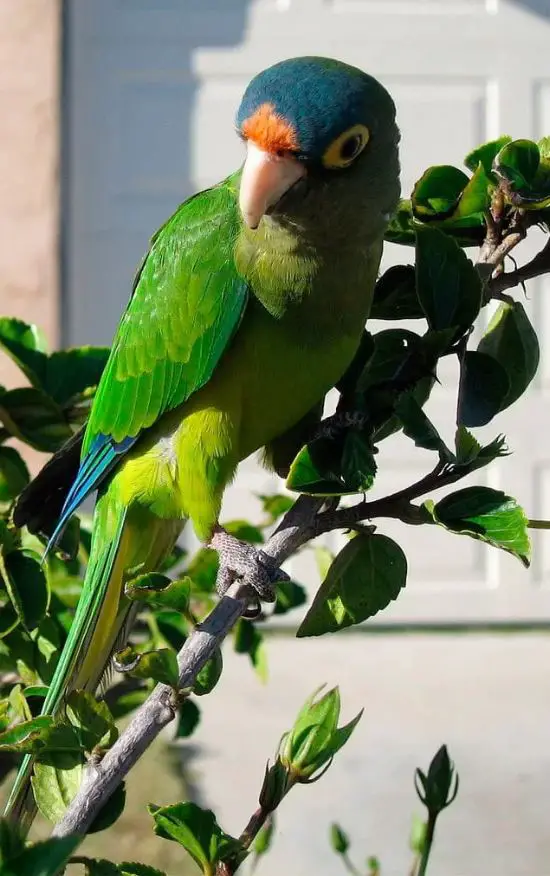
Scientific name: Eupsittula canicularis
Order: Psittaciformes
Family: Psittacidae
Genus: Eupsittula
Height: 24 cm
Longevity: 20 to 30 years
Distribution: This bird lives in Mexico and Costa Rica in wooded areas up to 1,500 m altitude.
Description: The Red-fronted Parakeet or Orange-fronted Parakeet is very closely related to the Crowned Parakeet. This species differs from the Crowned Parakeet by the more orange coloring of the forehead, hence one of its vernacular names, by the more extensive blue of the head, and by the light coloring of the beak.
Subspecies: Eburnirostrum, Clare.
The subspecies, Eupsittula canicularis eburnirostrum
Cactus conure
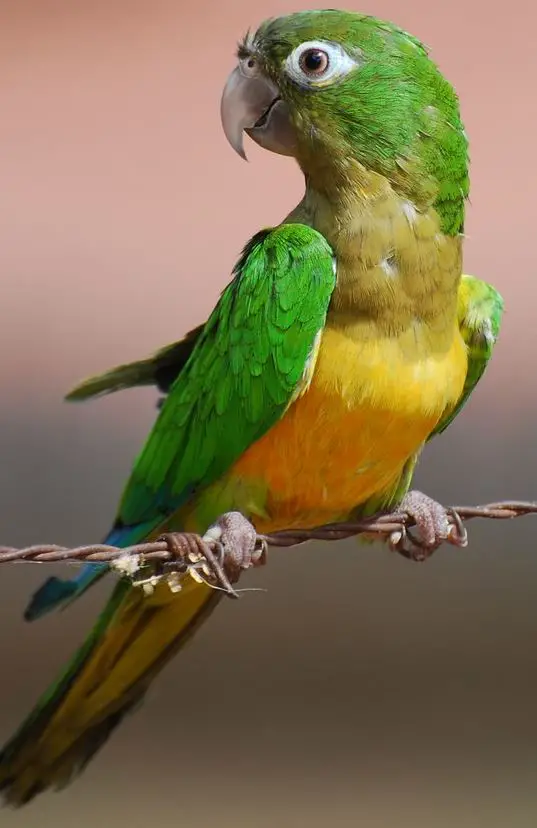
Scientific name: Eupsittula cactorum
Order: Psittaciformes
Family: Psittacidae
Genus: Eupsittula
Size: About 25cm.
Longevity: 15-30 years
Distribution: Northeastern Brazil
Subspecies: Caixana, Cactorum cactorum
Aratinga conure
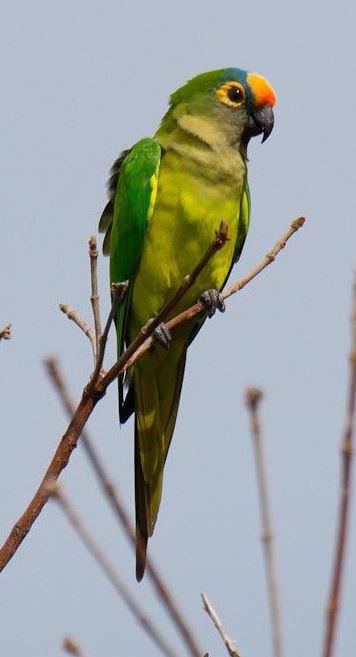
Scientific name: Eupsittula aurea
Order: Psittaciformes
Family: Psittacidae
Genus: Eupsittula
Size: About 26cm.
Longevity: 20–30 years
Distribution: This species frequents secondary forests bordering the Amazon River basin and the cerrado.
Description: The plumage has a green cast, lighter on the ventral parts. The forehead is golden red shaded with blue. The eye rings are yellow and the irises are red.
The beak is black and the legs greyish. The flight feathers and primary coverts are blue in the adults and azure in the young which show a lighter general coloring and gray irises.
Subspecies: Larger Eupsittula aurea major.
Sharp conure
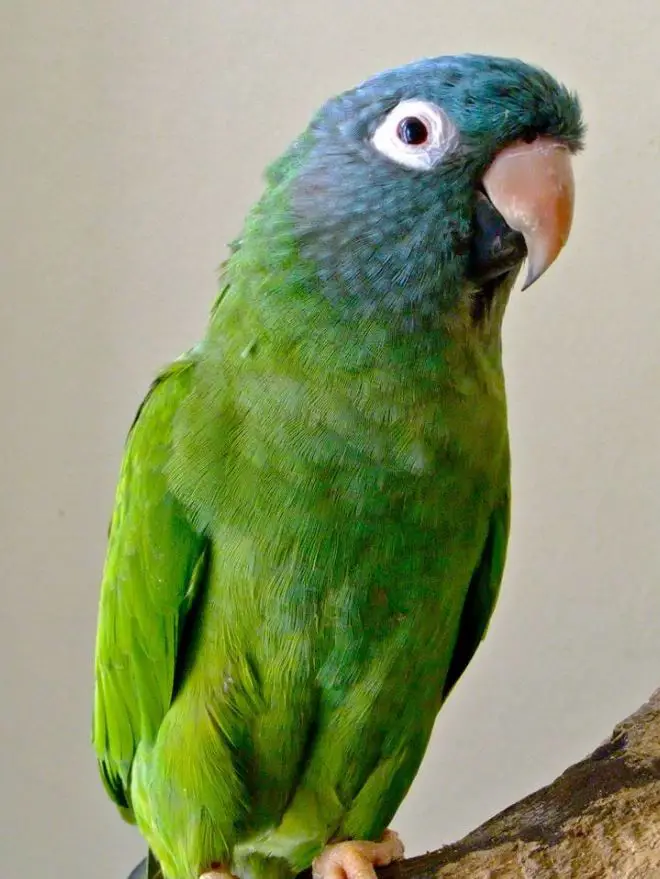
Scientific name: Psittacara acuticaudatus acuticaudatus
Order: Psittaciformes
Family: Psittacidae
Genre: Psittacara
Classification: Psittaciformes family of psittacidae.
Height: About 38 cm
Longevity: 25 years
Distribution: Extreme southwestern part of Brazil, eastern Bolivia south to northern Argentina and Uruguay.
Description: The Blue-headed Parakeet is a conure with predominantly green plumage. Blue-capped Parakeet’s plumage is green, brighter on the upperparts, and more nuanced on the underparts.
The face of this bird is colored blue, hence the specific name, more or less extended according to age, subspecies, and individual. Bare skin eyering is white. The upper mandible is brown with a black tip, the latter color being that of the lower mandible. The legs are pink.
Subspecies: Acuticaudata, Haemorrhous, Koenigi, Neoxena, Neumanni.
Scarlet-fronted conure
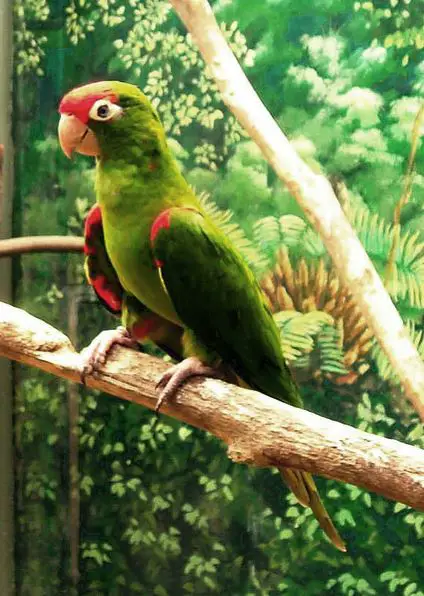
Scientific name: Psittacara wagleri
Order: Psittaciformes
Family: Psittacidae
Genre: Psittacara
Classification: Psittaciformes of the Neotropical Psittacidae family.
Height: About 36cm.
Longevity: 30 years
Distribution: This bird lives in forests up to 3000 m altitude. This species lives in the Andes between Venezuela and Peru.
Description: It has green plumage with red mainly on the forehead and crown. This species belongs to the group of red-fronted green conures with Finsch’s Parakeet, Mitred Parakeet, and Red-headed Parakeet.
Subspecies: Psittacara wagleri transits with red neck scales, too, but darker green plumage, Psittacara wagleri frontatus with red shoulder patches, Psittacara wagleri minor with red shoulder patches also but large smaller.
Carolina conure
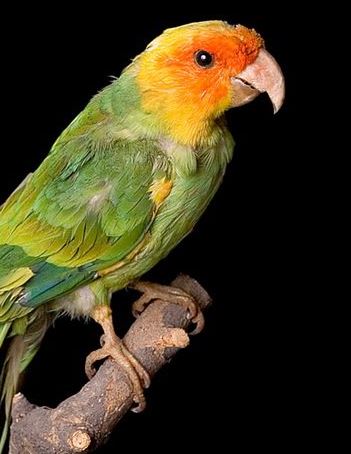
Scientific name: Conuropsis carolinensis
Order: Psittaciformes
Family: Psittacidae
Genus: Conuropsis
Size: 30 to 35 cm
Longevity: 10-30 years
Distribution: Western regions of the United States.
Description: A green plumage, brighter on the back and wings than under the belly. The anterior region of the head was orange. The wings bore yellow feathers on their undersides.
The beak was yellow, the eyes brown, and the legs grey. This species has been extinct for about 40 years. A parrot with the ability to live in the United States is in itself something singular, and there are amazing sightings of this species flying over snow-covered fields.
At the time of its abundance, the species liked wooded plains and showed a preference for land close to water. It lived mainly in plane trees, cypresses, or maples, and perched for the night in hollow stumps of branches inside which the individuals piled up and agglutinated.
At dawn, the birds would fly up to the upper branches of the trees and then lay quiet most of the day. Late afternoon and early evening saw strong bursts of activity. When the birds decided to feed, they quickly flew to chosen feeding sites and arrived in a blaze of color.
Subspecies: Conuropsis carolinensis carolinensis, Conuropsis carolinensis ludoviciana.
Patagonian conure
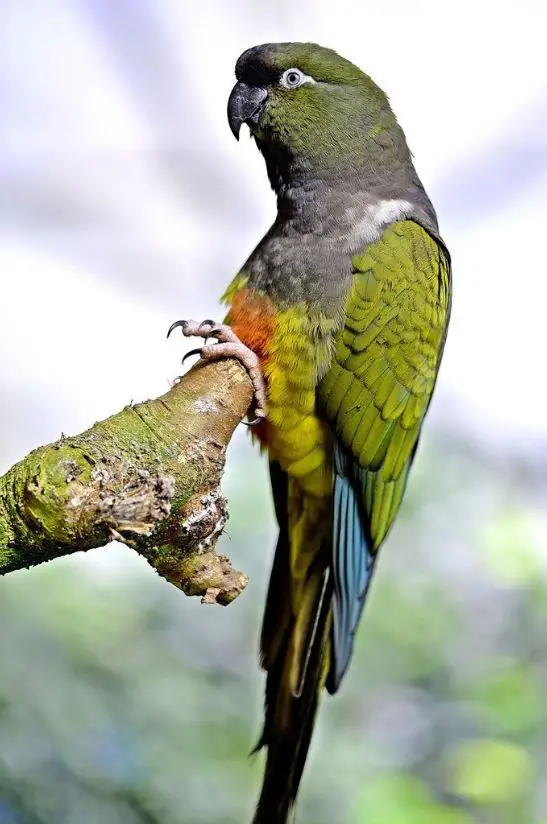
Scientific name: Cyanoliseus patagonus
Order: Psittaciformes
Family: Psittacidae
Genre: Cyanoliseus
Scientific name: Cyanoliseus Patagonus
Classification: Patagonian Parakeet is a species of bird in the Psittacidae family.
Height: 43 to 47 cm.
Longevity: 30 years
Distribution: It inhabits Argentina, Chile, and southern Uruguay. Originally, the species extended from the Atacama Desert to the city of Valdivia, almost in Patagonia.
Description: It’s head and back are dark olive green with brownish undertones. This species has an eye-ring of white bare skin. The irises are clear.
The upper part of the chest is whitish, while its lower part is olive green. The abdomen, thighs, back, and shoulders are yellow in color. The central part of the abdomen is orange. The wings are olive in color.
The tail is olive-grey. The black to dark gray-blue bill is hooked and short. Finally, the legs, thin compared to the size of the bird, are pale pink. It is a gregarious species, an excellent sailmaker, very turbulent and noisy.
The swarm in flight can be heard from very far away. The bird’s nest in cavities dug in the high and sandy banks of rivers, the walls of ravines or precipices, hence their name of Loro Barranquero meaning in French parrot of the ravines.
They inhabit these cavities throughout the year. Their caves are deep (up to 3 m deep for a diameter of 18 cm) and zigzagging. They end in a brooding chamber.
Nesting is of the colonial type and probably cooperative (all the adults then participating in the rearing of all the young). The Patagonian Parakeet is very shy if newly imported.
Its cries are piercing, so watch out for neighbors. If she was raised by hand, she is very cuddly and tender. However, avoid putting it in contact with unsupervised children because it has an impressive force in the beak.
Subspecies: Cyanoliseus patagonus patagonus, Cyanoliseus patagonus andinus, Cyanoliseus patagonus bloxami, Cyanoliseus patagonus conlara, Cyanoliseus patagonus byroni.
Austral conure
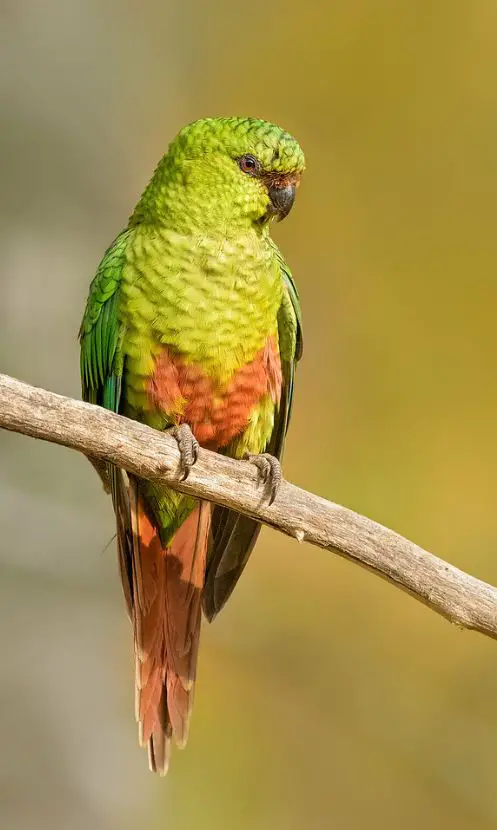
Scientific name: Enicognathus ferrugineus
Order: Psittaciformes
Family: Psittacidae
Genus: Enicognathus
Height: About 33cm.
Longevity: more than 30 years
Distribution: This conure lives in Chile and Argentina (as far as Tierra del Fuego).
Description: It resembles the Long-billed Parakeet but is distinguished by the absence of red on the forehead, darker and more extensive scales at the level of the green feathers of the crown and back, and especially by a shaped beak. classic for the Psittacidae family.
Subspecies: Enicognathus ferrugineus ferrugineus, Enicognathus ferrugineus minor (smaller in size as the name suggests).
Austral conure
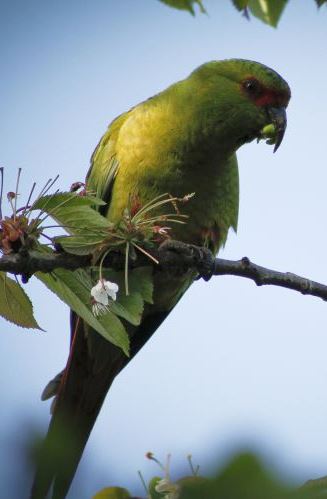
Scientific name: Enicognathus leptorhynchus
Order: Psittaciformes
Family: Psittacidae
Genus: Enicognathus
Size: About 40cm.
Longevity: 15 Years
Distribution: This species lives in mountain forests around 2,000 m or more. It only frequents open areas and fields in the spring when it descends to the plateaus. The Long-billed Parakeet is endemic to Chile.
Description: It is characterized by a fairly light and thin beak, blackish in color, with a long and curved upper mandible. The plumage shows a green cast but the black edges of the crown and back feathers produce a scaly appearance.
The forehead is red. The ventral plastron and the tail are brick red. The irises are orange and the legs grey. Juveniles show a shorter upper mandible and darker plumage.
Subspecies: Enicognathus leptorhynchus leptorhynchus, Enicognathus leptorhynchus Byron.
Golden conure

Scientific name: Guaruba guarouba
Order: Psittaciformes
Family: Psittacidae
Genre: Guaruba
Classification: The Golden conure is a species of bird in the Psittacidae family, endemic to Brazil. This species is the only one of the guaruba genus. It is sometimes classified among the aratingas.
Size: 34cm.
Longevity: 30 Years
Distribution: The Golden Parakeet inhabits the tropical primary forests of the Brazilian Amazon.
Description: As its name suggests, the Golden conure has mostly bright yellow plumage, complemented by dark green primary and secondary coverts. The eye rings are white, the beak greyish, the irises brown and the legs pink. Juveniles are olive green instead of yellow.
Golden plumed conure

Scientific name: Leptosittaca branickii
Order: Psittaciformes
Family: Psittacidae
Genus: Leptosittaca
Height: About 35cm.
Distribution: The Golden-brushed Parakeet inhabits temperate forests between 1400 and 3400 m. This bird lives in the Andes between Colombia and Peru.
Description: It has green plumage, lighter on the underside of the body. The back of the neck has a golden yellow mark that extends behind the eyes.
The bottom of the chest is streaked with red, coloration found at the level of the underside of the wings and the tail. The orbital circles are white and the irises orange. Beak and legs are greyish. This species does not exhibit sexual dimorphism.
Yellow eared conure

Scientific name: Ognorhynchus icterotis
Order: Psittaciformes
Family: Psittacidae
Genus: Ognorhynchus
Size: About 42cm.
Longevity: 20 years
Distribution: This species occupies temperate subtropical forests between 2,500 and 3,200 m altitude characterized by the presence of the Ceroxylon and column palm to which it is dependent.
The Golden-cheeked Parakeet is very rare in the Andes between Colombia and Ecuador where it is endangered due to habitat destruction.
Thick-billed conure

Scientific name: Rhynchopsitta pachyrhyncha
Order: Psittaciformes
Family: Psittacidae
Genre: Rhynchopsitta
Height: About 38cm.
Longevity:
Distribution: This bird lives in the western Sierra Madre in Mexico.
Description: He has a sturdy, stocky body. Its plumage is green with red markings on the forehead, above the eyes, on the shoulders, and on the breeches.
The eye-rings are yellowish and the irises orange. The beak is black and the legs are grey. The red coloring is less extensive and the beak is greyish in the juvenile.
Subspecies: Rhynchopsitta terrisi (brown-fronted conure).
Rare Conure Species
SOURCE:Deepan’s Birds & Vlogs

